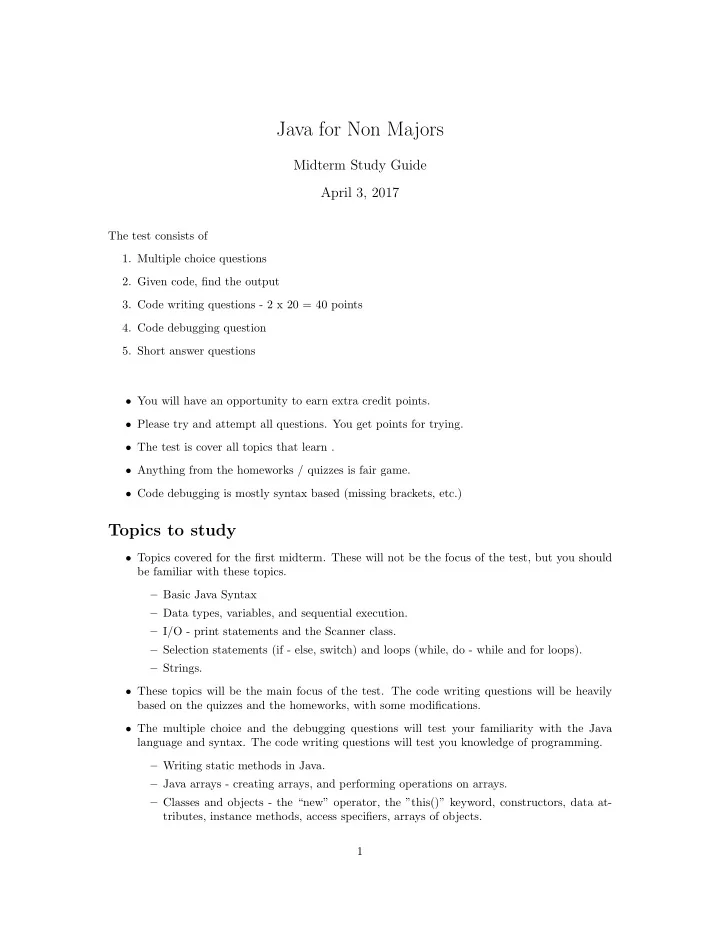

Java for Non Majors Midterm Study Guide April 3, 2017 The test consists of 1. Multiple choice questions 2. Given code, find the output 3. Code writing questions - 2 x 20 = 40 points 4. Code debugging question 5. Short answer questions • You will have an opportunity to earn extra credit points. • Please try and attempt all questions. You get points for trying. • The test is cover all topics that learn . • Anything from the homeworks / quizzes is fair game. • Code debugging is mostly syntax based (missing brackets, etc.) Topics to study • Topics covered for the first midterm. These will not be the focus of the test, but you should be familiar with these topics. – Basic Java Syntax – Data types, variables, and sequential execution. – I/O - print statements and the Scanner class. – Selection statements (if - else, switch) and loops (while, do - while and for loops). – Strings. • These topics will be the main focus of the test. The code writing questions will be heavily based on the quizzes and the homeworks, with some modifications. • The multiple choice and the debugging questions will test your familiarity with the Java language and syntax. The code writing questions will test you knowledge of programming. – Writing static methods in Java. – Java arrays - creating arrays, and performing operations on arrays. – Classes and objects - the “new” operator, the ”this()” keyword, constructors, data at- tributes, instance methods, access specifiers, arrays of objects. 1
– Inheritance, Interfaces and Polymorphism- the protected access specifier; static, final and abstract modifiers, the ”super()” keyword, extends and implements, casting classes, method overwriting, creating abstract class and interface • Studying the topics listed above will be enough to pass the test. To get a 100, you would be required to study everything on the notes. Some Sample Questions 1. Which of the following is NOT a Java access specifier? (a) public (b) private (c) abstract (d) protected 2. The class “Coffee” has a single data attribute “price”. Which of the following methods can be private? (a) void calcTax() (b) Coffee(double p) (c) void setPrice (double p) (d) double getPrice() 3. A variable declared inside a block is available (a) throughout the program (b) only in that block (c) only in that class (d) only in that method 4. An object consists of (a) Name (b) Attributes (c) Methods (d) All of the above 5. A class is a single instance of an object (a) True (b) False 6. Animal s1, s2, s3; // Animal is the base class s2 = new Bird(); Bird c = new Bird(); // Bird is a derived class Please choose all correct options below. (a) s1 = c; 2
(b) s1 = (Animal)c; (c) s3 = new Bird(); (d) c = s2; (e) c = (Bird)s2; 7. What is the difference btw instance method and static method? 8. What is data hiding? What is the difference btw public, private and protected? 9. What is the default constructor? 10. What is the abstract class and methods? How can we create them? 11. Write a program to read in 10 strings from the user. Combine them into one string. Then replace all occurrences of the letter ‘e’ with the letter ‘i’ and print the string. 12. Write a method to create an array of integers. Take the size of the array as the parameter Use the Random library to fill the array with data. Then, calculate and print the sum of all the odd numbers in the array. 13. Define a class Tree, with the attributes “species” - string, “age” - integer and “isEvergreen” - boolean. Write a parameterized constructor, accessor and mutator methods, and a print method. In the main method, create one instance of the class and print its values. 3
Recommend
More recommend